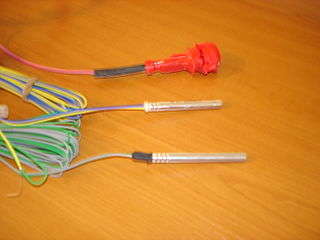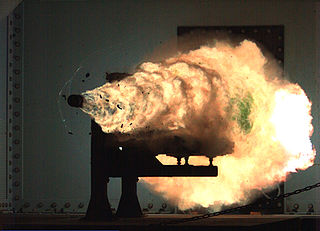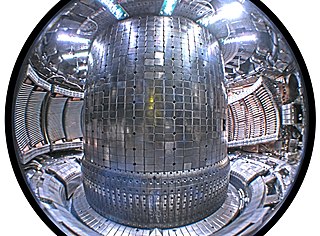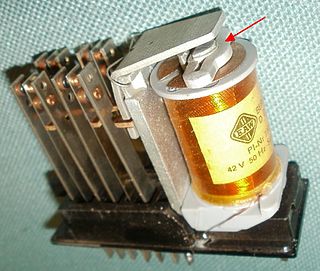Related Research Articles

A detonator, frequently a blasting cap, is a device used to trigger an explosive device. Detonators can be chemically, mechanically, or electrically initiated, the last two being the most common.

A railgun is a linear motor device, typically designed as a weapon, that uses electromagnetic force to launch high velocity projectiles. The projectile normally does not contain explosives, instead relying on the projectile's high speed, mass, and kinetic energy to inflict damage. The railgun uses a pair of parallel conductors (rails), along which a sliding armature is accelerated by the electromagnetic effects of a current that flows down one rail, into the armature and then back along the other rail. It is based on principles similar to those of the homopolar motor.

An alternator is an electrical generator that converts mechanical energy to electrical energy in the form of alternating current. For reasons of cost and simplicity, most alternators use a rotating magnetic field with a stationary armature. Occasionally, a linear alternator or a rotating armature with a stationary magnetic field is used. In principle, any AC electrical generator can be called an alternator, but usually the term refers to small rotating machines driven by automotive and other internal combustion engines.
An explosively pumped flux compression generator (EPFCG) is a device used to generate a high-power electromagnetic pulse by compressing magnetic flux using high explosive.

The exploding-bridgewire detonator is a type of detonator used to initiate the detonation reaction in explosive materials, similar to a blasting cap because it is fired using an electric current. EBWs use a different physical mechanism than blasting caps, using more electricity delivered much more rapidly, and explode in a much more precise timing after the electric current is applied, by the process of exploding wire method. This has led to their common use in nuclear weapons.

A synchronous electric motor is an AC motor in which, at steady state, the rotation of the shaft is synchronized with the frequency of the supply current; the rotation period is exactly equal to an integral number of AC cycles. Synchronous motors contain multiphase AC electromagnets on the stator of the motor that create a magnetic field which rotates in time with the oscillations of the line current. The rotor with permanent magnets or electromagnets turns in step with the stator field at the same rate and as a result, provides the second synchronized rotating magnet field of any AC motor. A synchronous motor is termed doubly fed if it is supplied with independently excited multiphase AC electromagnets on both the rotor and stator.

In electrical engineering, an armature is the component of an electric machine which carries alternating current. The armature windings conduct AC even on DC machines, due to the commutator action or due to electronic commutation, as in brushless DC motors. The armature can be on either the rotor or the stator, depending on the type of electric machine.
Doubly-fed electric machines also slip-ring generators are electric motors or electric generators, where both the field magnet windings and armature windings are separately connected to equipment outside the machine.
A brushed DC electric motor is an internally commutated electric motor designed to be run from a direct current power source. Brushed motors were the first commercially important application of electric power to driving mechanical energy, and DC distribution systems were used for more than 100 years to operate motors in commercial and industrial buildings. Brushed DC motors can be varied in speed by changing the operating voltage or the strength of the magnetic field. Depending on the connections of the field to the power supply, the speed and torque characteristics of a brushed motor can be altered to provide steady speed or speed inversely proportional to the mechanical load. Brushed motors continue to be used for electrical propulsion, cranes, paper machines and steel rolling mills. Since the brushes wear down and require replacement, brushless DC motors using power electronic devices have displaced brushed motors from many applications.
The International Symposium on Computer Architecture (ISCA) is an annual academic conference on computer architecture, generally viewed as the top-tier in the field. Association for Computing Machinery's Special Interest Group on Computer Architecture and Institute of Electrical and Electronics Engineers Computer Society are technical sponsors.
Ward Leonard control, also known as the Ward Leonard drive system, was a widely used DC motor speed control system introduced by Harry Ward Leonard in 1891. In the early 1900s, the control system of Ward Leonard was adopted by the U.S. Navy and also used in passenger lifts of large mines. It also provided a solution to a moving sidewalk at the Paris Exposition of 1900, where many others had failed to operate properly. It was applied to railway locomotives used in World War I, and was used in anti-aircraft radars in World War II. Connected to automatic anti-aircraft gun directors, the tracking motion in two dimensions had to be extremely smooth and precise. The MIT Radiation Laboratory selected Ward-Leonard to equip the famous radar SCR-584 in 1942. The Ward Leonard control system was widely used for elevators until thyristor drives became available in the 1980s, because it offered smooth speed control and consistent torque. Many Ward Leonard control systems and variations on them remain in use.

An electric generator or electric motor consists of a rotor spinning in a magnetic field. The magnetic field may be produced by permanent magnets or by field coils. In the case of a machine with field coils, a current must flow in the coils to generate the field, otherwise no power is transferred to or from the rotor. The process of generating a magnetic field by means of an electric current is called excitation. Field coils yield the most flexible form of magnetic flux regulation and de-regulation, but at the expense of a flow of electric current. Hybrid topologies exist, which incorporate both permanent magnets and field coils in the same configuration. The flexible excitation of a rotating electrical machine is employed by either brushless excitation techniques or by the injection of current by carbon brushes.
An explosive-driven ferromagnetic generator is a compact pulsed power generator, a device used for generation of short high-voltage high-current pulse by releasing energy stored in a permanent magnet. It is suited for delivering high-current pulses (kiloamperes) to low-impedance loads.

In electrical engineering, a protective relay is a relay device designed to trip a circuit breaker when a fault is detected. The first protective relays were electromagnetic devices, relying on coils operating on moving parts to provide detection of abnormal operating conditions such as over-current, overvoltage, reverse power flow, over-frequency, and under-frequency.
Audification is an auditory display technique for representing a sequence of data values as sound. By definition, it is described as a "direct translation of a data waveform to the audible domain." Audification interprets a data sequence and usually a time series, as an audio waveform where input data are mapped to sound pressure levels. Various signal processing techniques are used to assess data features. The technique allows the listener to hear periodic components as frequencies. Audification typically requires large data sets with periodic components.

In nuclear fusion power research, the plasma-facing material (PFM) is any material used to construct the plasma-facing components (PFC), those components exposed to the plasma within which nuclear fusion occurs, and particularly the material used for the lining the first wall or divertor region of the reactor vessel.
Sheet explosives are materials formed by combining an explosive with a "rubberizer"—a flexible binding agent. The resulting compound is cast into a flat sheet which is typically pliable and deformable over a wide range of temperature. Typical products are generally shock-insensitive secondary explosives, requiring a blasting cap or other detonator.
An electromagnetic pulse (EMP), also sometimes called a transient electromagnetic disturbance, is a short burst of electromagnetic energy. Such a pulse's origin may be a natural occurrence or human-made and can occur as a radiated, electric, or magnetic field or a conducted electric current, depending on the source.

Hanspeter Pfister is a Swiss computer scientist. He is the An Wang Professor of Computer Science at the Harvard John A. Paulson School of Engineering and Applied Sciences and an affiliate faculty member of the Center for Brain Science at Harvard University. His research in visual computing lies at the intersection of scientific visualization, information visualization, computer graphics, and computer vision and spans a wide range of topics, including biomedical image analysis and visualization, image and video analysis, and visual analytics in data science.

A shading coil or shading ring is a single turn of electrical conductor located in the face of the magnet assembly or armature of an alternating current solenoid. The alternating current in the energized primary coil induces an alternating current in the shading coil. This induced current creates an auxiliary magnetic flux which is 90 degrees out of phase from the magnetic flux created by the primary coil.
References
- ↑ "Welcome to Explosives Camp". Archived from the original on 2008-06-28. Retrieved 2008-06-20.
- 1 2 "Paul Worsey : The Detonators : Discovery Channel". Archived from the original on 2009-03-25. Retrieved 2009-06-08.
- ↑ "StemPlug". Archived from the original on 2008-03-31. Retrieved 2008-06-20.
- 1 2 "Teaching experience". Archived from the original on 2008-03-31. Retrieved 2008-06-20.
- 1 2 "First session of explosives camp starts June 8" . Retrieved 2008-06-20.[ dead link ]
- ↑ Schwartz, John (July 3, 2007). "A Summer Camp Where Fireworks Are the Point". The New York Times. Retrieved 2008-06-20.
- ↑ Morris, Frank. "At Camp, Teens Blow Stuff Up, As They're Told" . Retrieved 2008-06-20.
- ↑ Schwartz, John (July 3, 2007). "Having a blast at explosives camp" . Retrieved 2008-06-20.